1995 CHEVROLET CORVETTE coolant temperature
[x] Cancel search: coolant temperaturePage 149 of 386

Downloaded from www.Manualslib.com manuals search engine Temperature Sensors
Sunload:
This sensor is on top of the instrument panel.
When the inside temperature
is increased by sunlight,
the system will lower the inside temperature up to
5°F
(3 “C) below the setting on the display.
Outside Temperature: This sensor is on the right side
of the upper radiator support in the grille opening. This
is what you usually see on the display.
If the outside temperature goes up, the displayed
temperature will not change until:
a Vehicle speed is above 25 mph (40 km/h) for at least
0 Vehicle speed is above 45 mph (72 km/h) for
This delay helps prevent a false reading. If vehicle speed
remains above
25 mph (40 km/h) or the temperature
goes down, the display is updated immediately.
If your vehicle has been off for more than three hours,
the current outside temperature will be stored in the
system when you start the vehicle.
Inside temperature: This sensor is in the center air
outlet
on the passenger side.
If you block or cover either interior sensor, the system
will give a false reading.
3 minutes, or
1 1/2 minutes.
Automatic Control
The system will adjust to maintain the temperature you
set. It will select the best fan speed and aifflow setting to
keep you comfortable with the least amount of noise.
Press the arrows on the TEMP SET switch’to set a
comfortable temperature. Then press AUTO
and the fan
speed will adjust automatically unless you press the
arrows on the switch.
Manual Heating
The heater works best if you keep your windows closed
while using it.
Press the arrows on the TEMP SET switch to set a
comfortable temperature. Then press HEATER and, if
you don’t like the automatic setting, press the arrows on
the fan speed switch.
In AUTO FAN on cold days, the
fan will stay off until the coolant warms up enough to
heat your vehicle.
If your vehicle has an engine coolant heater and you use
it in cold weather,
0 OF (- 18 O C) or lower, your heating
system can provide heat more quickly because the
engine coolant is already warmed. See “Engine Coolant
Heater” in the Index.
3-6
Page 206 of 386
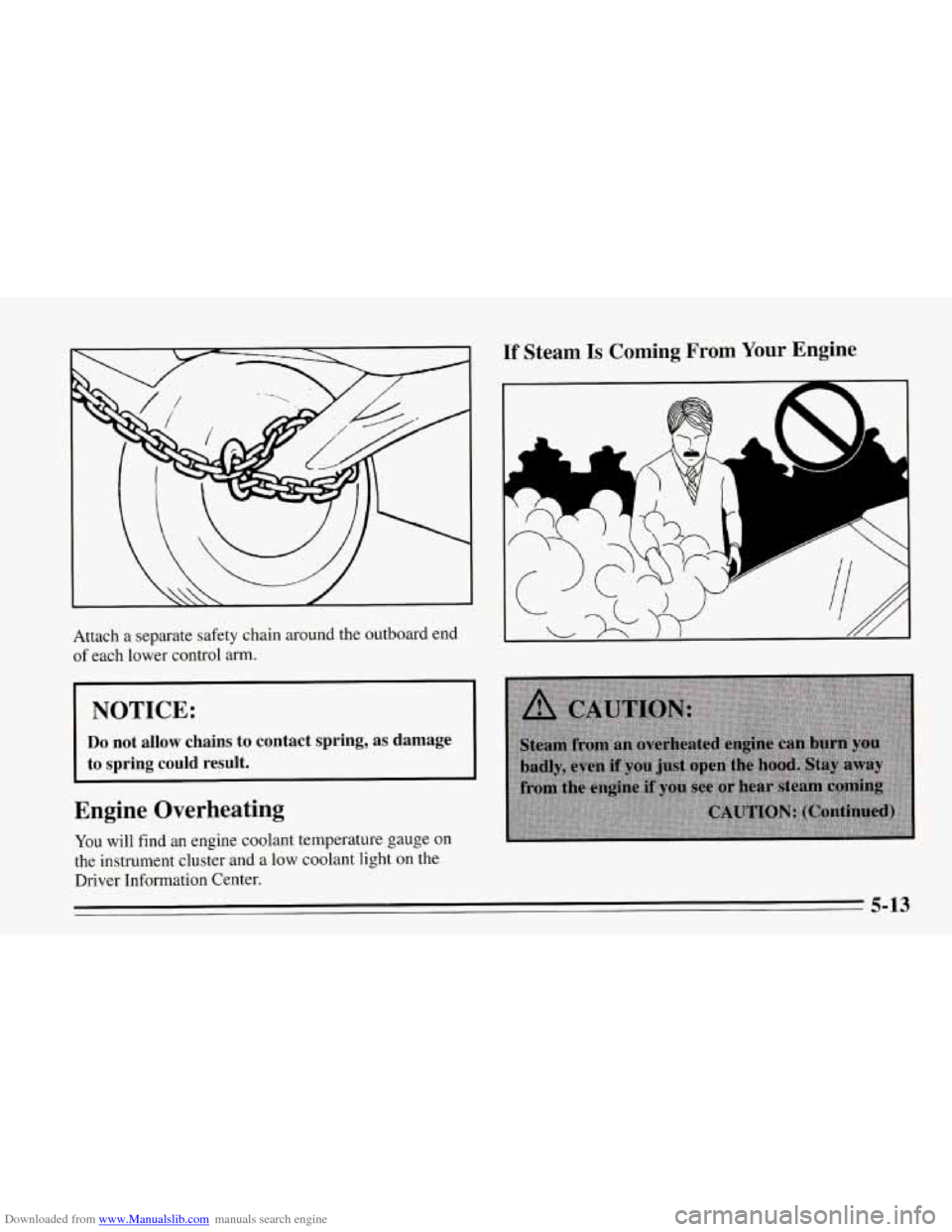
Downloaded from www.Manualslib.com manuals search engine Attach a separate safety chain around the outboard end
of each lower control arm.
I I
I NOTICE:
Do not allow chains to contact spring, as damage
to spring could result.
Engine Overheating
You will find an engine coolant temperature gauge on
the instrument cluster and a low coolant light on the
Driver Information Center.
If Steam Is Coming From Your Engine
'I
c
a
5-13
Page 251 of 386
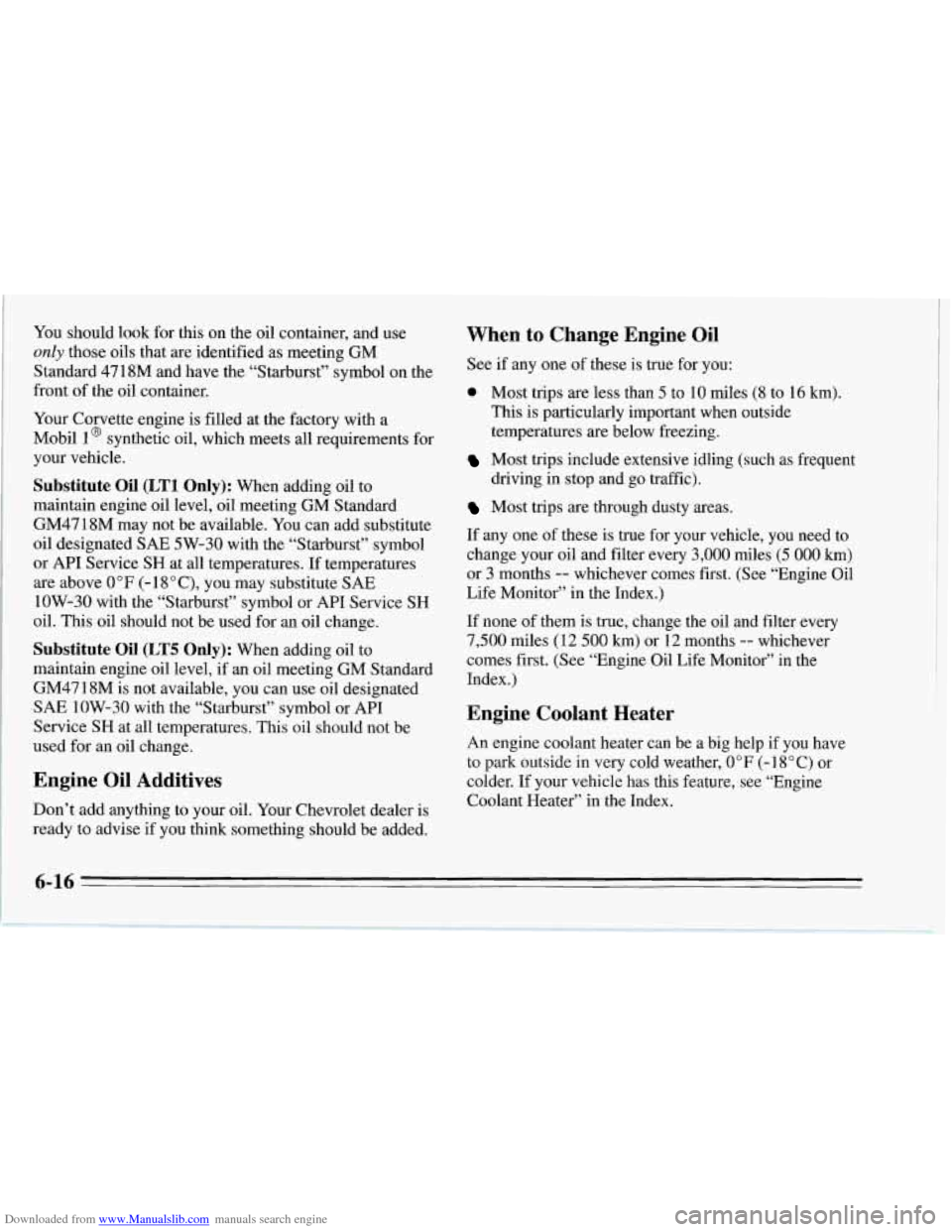
Downloaded from www.Manualslib.com manuals search engine You should look for this on the oil container, and use
only those oils that are identified as meeting GM
Standard
4718M and have the “Starburst” symbol on the
front of the oil container.
Your Corvette engine is filled at the factory with a
Mobil
1 @ synthetic oil, which meets all requirements for
your vehicle.
Substitute Oil (LTl Only): When adding oil to
maintain engine oil level, oil meeting GM Standard
GM47
18M may not be available. You can add substitute
oil designated
SAE 5W-30 with the “Starburst” symbol
or API Service SH at all temperatures. If temperatures
are above
0” F (- 18 O C), you may substitute SAE
1OW-30 with the “Starburst” symbol or API Service
SH
oil. This oil should not be used for an oil change.
Substitute Oil (LT5 Only): When adding oil to
maintain engine oil level,
if an oil meeting GM Standard
GM47
18M is not available, you can use oil designated
SAE 1OW-30 with the “Starburst” symbol or API
~ Service SH at all temperatures. This oil should not be
used for
an oil change.
Engine Oil Additives
Don’t add anything to your oil. Your Chevrolet dealer is
ready to advise if you think something should be added.
When to Change Engine Oil
See if any one of these is true for you:
0 Most trips are less than 5 to 10 miles (8 to 16 km).
This is particularly important when outside
temperatures are below freezing.
Most trips include extensive idling (such as frequent
driving in stop and
go traffic).
Most trips are through dusty areas.
If any one of these is true for your vehicle, you need to
change your oil and filter every 3,000 miles
(5 000 km)
or 3 months -- whichever comes first. (See “Engine Oil
Life Monitor” in the Index.)
If none of them is true, change the oil and filter every
7,500 miles (12 500 km) or 12 months -- whichever
comes first. (See “Engine Oil Life Monitor” in the
Index.)
Engine Coolant Heater
An engine coolant heater can be a big help if you have
to
park outside in very cold weather, 0” F (- 1 8 O C) or
colder. If your vehicle has this feature, see “Engine
Coolant Heater” in the Index.
6-16
Page 262 of 386
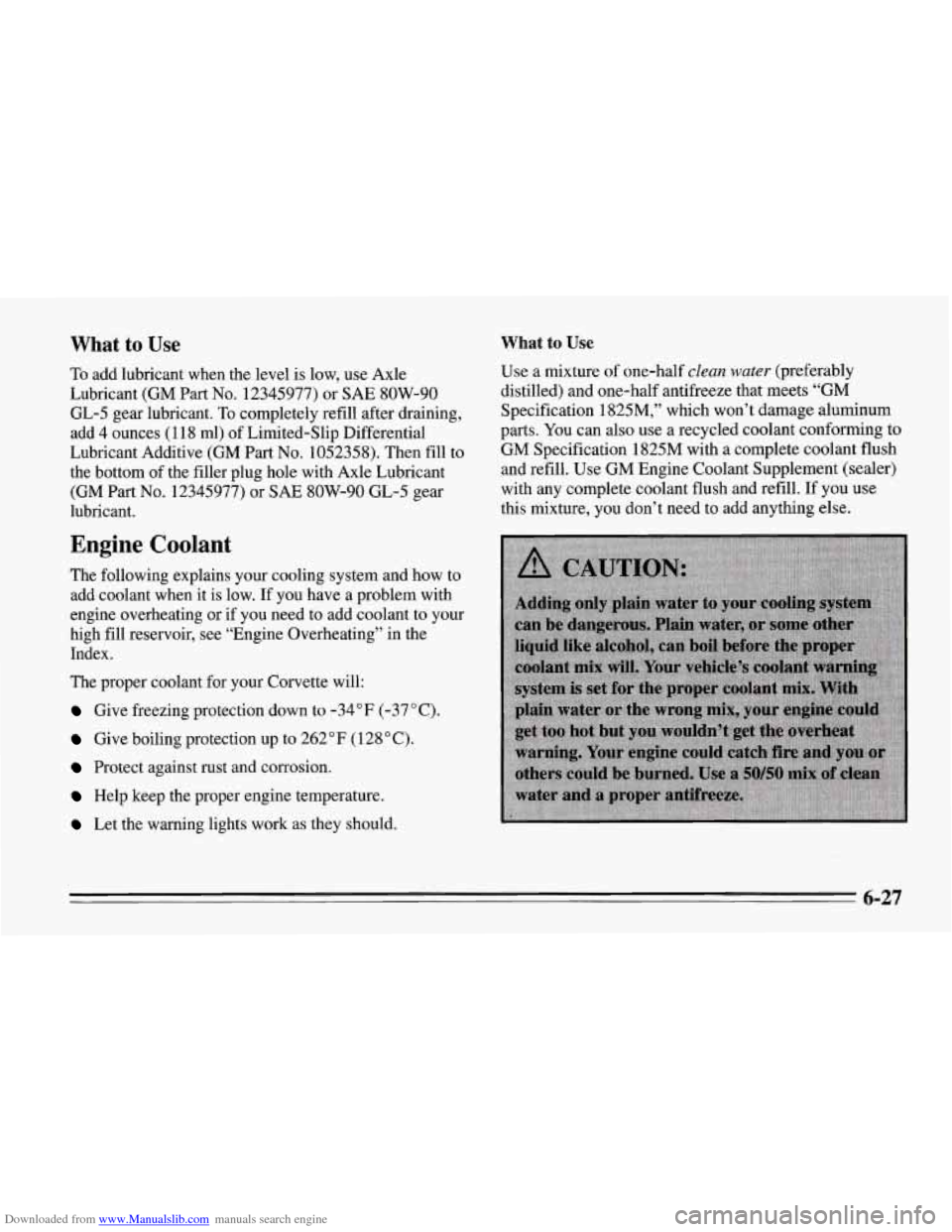
Downloaded from www.Manualslib.com manuals search engine What to Use What to Use
To add lubricant when the level is low, use Axle
Lubricant (GM Part
No. 12345977) or SAE SOW-90
GL-5 gear lubricant.
To completely refill after draining,
add
4 ounces (1 18 ml) of Limited-Slip Differential
Lubricant Additive (GM Part
No. 1052358). Then fill to
the bottom of the filler plug hole with Axle Lubricant
(GM Part
No. 12345977) or SAE 8OW-90 GL-5 gear
lubricant.
Engine Coolant
The following explains your cooling system and how to
add coolant when it is low.
If you have a problem with
engine overheating or if you need to add coolant to your
high fill reservoir, see “Engine Overheating” in the
Index.
The proper coolant for your Corvette will:
Give freezing protection down to -34°F (-37°C).
Give boiling protection up to 262 “F (128 ” C).
Protect against rust and corrosion.
Help keep the proper engine temperature.
Let the warning lights work as they should. Use a mixture
of one-half
clean water (preferably
distilled) and one-half antifreeze that meets
“GM
Specification 1825M,” which won’t damage aluminum
parts.
You can also use a recycled coolant conforming to
GM Specification 1825M with a complete coolant flush
and refill. Use GM Engine Coolant Supplement (sealer)
with any complete coolant flush and refill. If
you use
this mixture, you don’t need to add anything else.
6-27
Page 327 of 386
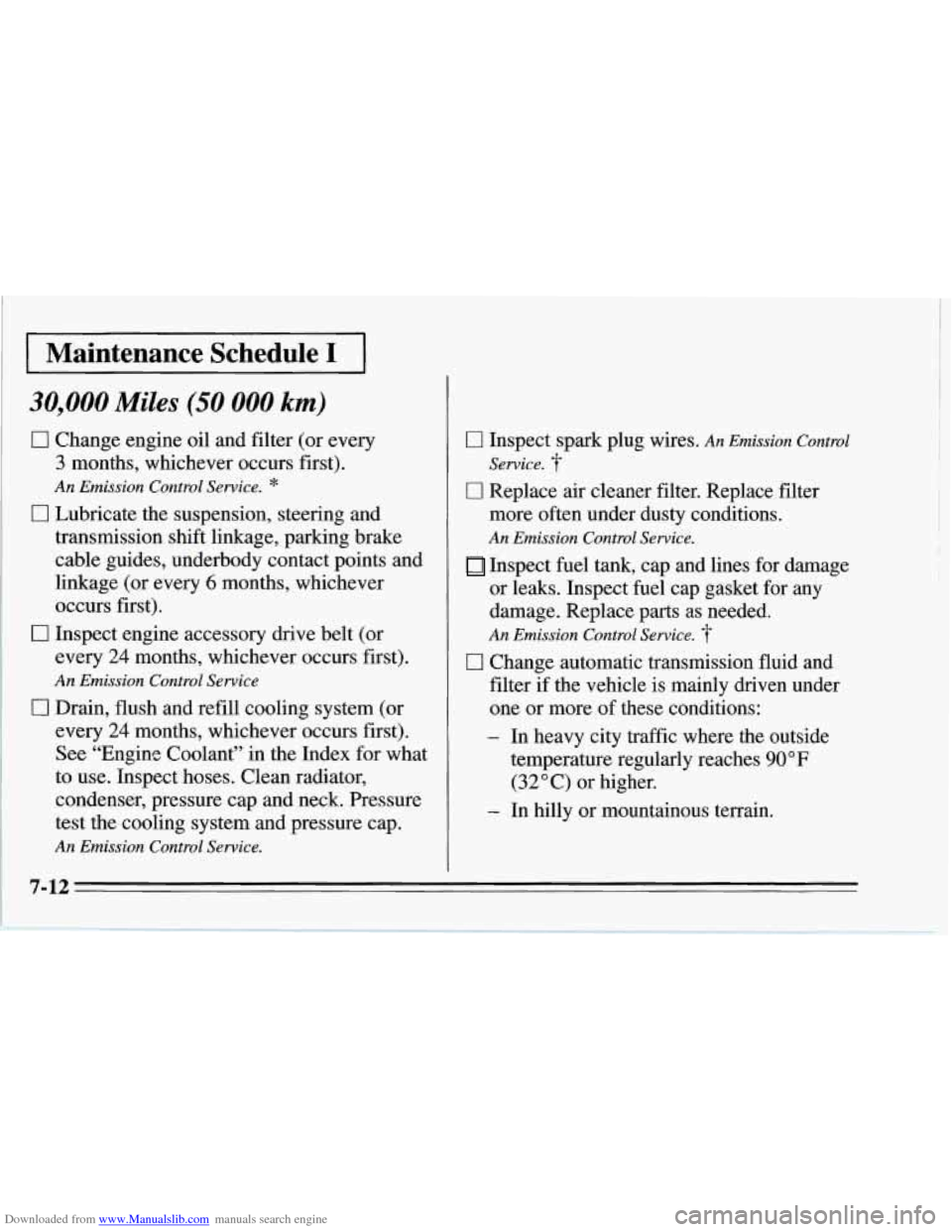
Downloaded from www.Manualslib.com manuals search engine Maintenance Schedule I
30,000 Miles (50 000 km)
0 Change engine oil and filter (or every [7 Inspect spark plug wires. An Emission Control
3 months, whichever occurs first). Service. -f-
An Emission Control Service. * [7 Replace air cleaner filter. Replace filter
17 Lubricate the suspension, steering and more often under dusty conditions.
transmission shift linkage, parking brake
An Emission Control Service.
cable guides, underbody contact Points and Inspect fuel tank, cap and lines for damage
linkage (or every
6 months, whichever or leaks. Inspect fuel cap gasket for any
occurs first). damage. Replace parts as needed.
every
24 months, whichever occurs first). 0 Change automatic transmission fluid and
An Emission Control Service filter if the vehicle is mainly driven under
every
24 months, whichever occurs first). - In heavy city traffic where the outside
See “Engine Coolant” in the Index for what temperature regularly reaches 90 O F
to use. Inspect hoses. Clean radiator, (32 O C) or higher.
condenser, pressure cap and neck. Pressure
test the cooling system and pressure cap.
0 Inspect engine accessory drive belt (or An Emission Control Service. -f-
0 Drain, flush and refill cooling system (or one or more of these conditions:
- In hilly or mountainous terrain.
An Emission Control Service.
7-12
Page 350 of 386
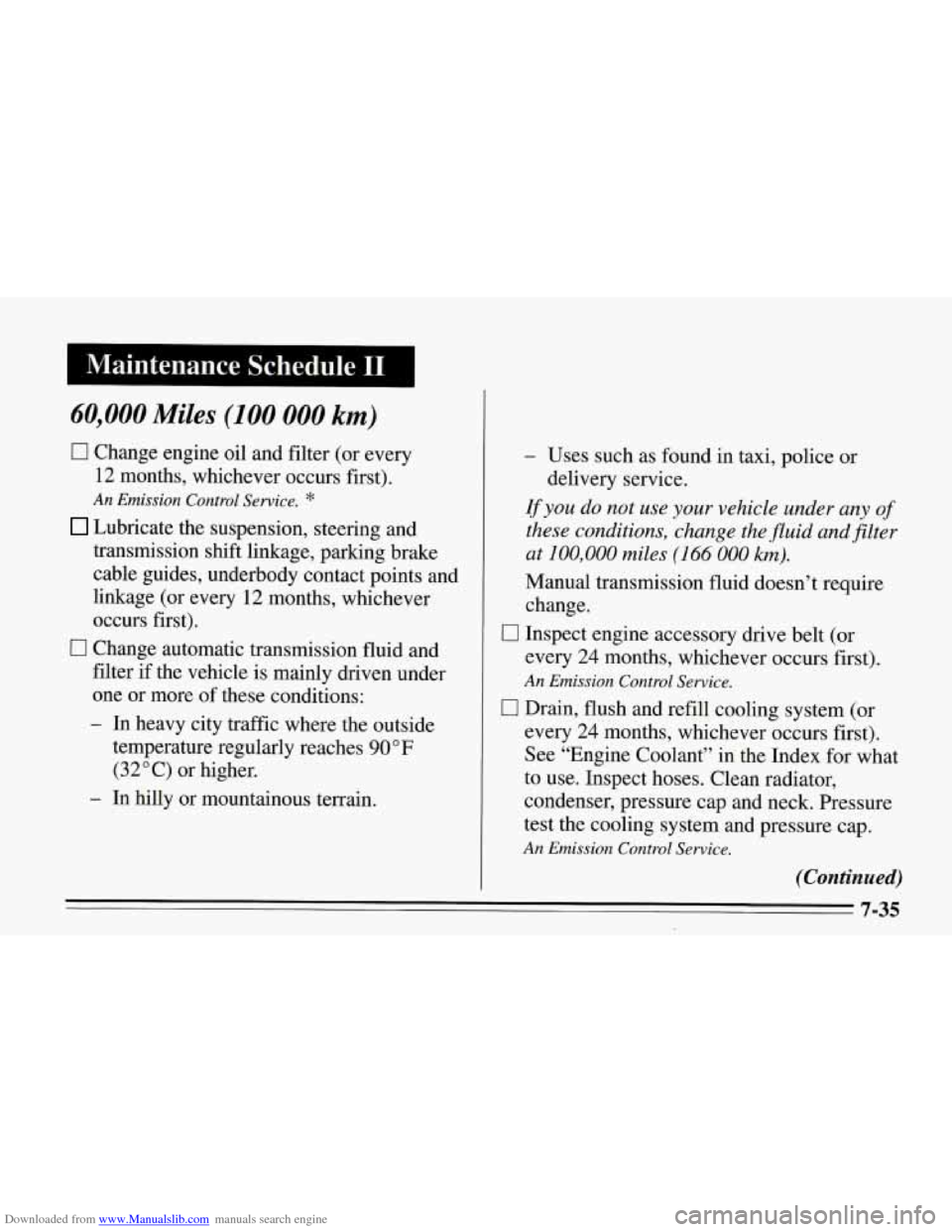
Downloaded from www.Manualslib.com manuals search engine 60,000 Miles (100 000 km)
0 Change engine oil and filter (or every
12 months, whichever occurs first).
An Emission Control Service. *
Lubricate the suspension, steering and
transmission shift linkage, parlung brake
cable guides, underbody contact points and
linkage (or every
12 months, whichever
occurs first).
0 Change automatic transmission fluid and
filter if the vehicle is mainly driven under
one or more of these conditions:
- In heavy city traffic where the outside
temperature regularly reaches
90 OF
(32 O C) or higher.
- In hilly or mountainous terrain.
- Uses such as found in taxi, police or
lfyou do not use your vehicle under any of
these conditions, change the fluid and filter
at
100,000 miles (I 66 000 km).
Manual transmission fluid doesn’t require
change.
every
24 months, whichever occurs first).
0 Drain, flush and refill cooling system (or
every
24 months, whichever occurs first).
See “Engine Coolant” in the Index for what
to use. Inspect hoses. Clean radiator,
condenser, pressure cap and neck. Pressure
test the cooling system and pressure cap.
delivery service.
0 Inspect engine accessory
drive belt (or
An Emission Control Service.
An Emission Control Service.
(Continued)
7-35
Page 378 of 386
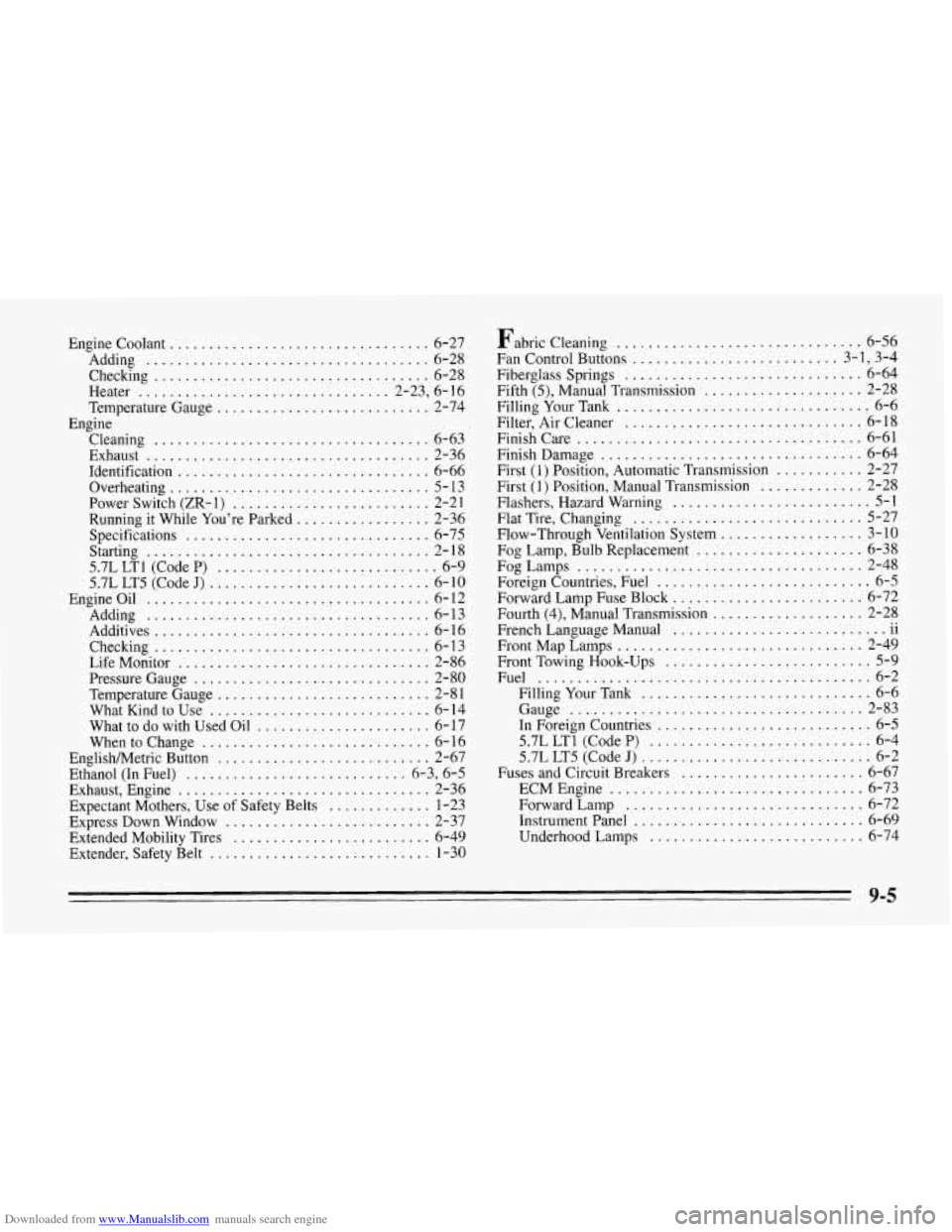
Downloaded from www.Manualslib.com manuals search engine Engine Coolant ................................. 6-27
Adding
.................................... 6-28
Checking
................................... 6-28
Heater
................................ 2-23, 6-16
Temperature Gauge
........................... 2-74
Engine
Cleaning
................................... 6-63
Exhaust
.................................... 2-36
Identification
................................ 6-66
Overheating
................................. 5-13
Power Switch (ZR-
1) ......................... 2-2 1
Running it While You’re Parked ................. 2-36
Specifications
............................... 6-75
5.7L LT1 (Code P) ............................ 6-9
5.7L LT5 (Code
J) ............................ 6- 10
Adding .................................... 6-13
Additives
................................... 6-16
Checking
................................... 6-13
Life Monitor
................................ 2-86
Pressure Gauge
.............................. 2-80
Temperature Gauge
........................... 2-8 1
What Kind to Use
............................ 6-14
What to do with Used Oil
...................... 6-17
When to Change
............................. 6- 16
EnglishMetric Button
........................... 2-67
Ethanol (In Fuel)
............................ 6-3, 6-5
Exhaust, Engine ................................ 2-36
Expectant Mothers, Use of Safety Belts
............. 1-23
Express Down Window
.......................... 2-37
Extended Mobility Tires
......................... 6-49
Extender, Safety Belt
............................ 1-30
Starting
.................................... 2-18
Engineoil
.................................... 6-12 Fabric
Cleaning
............................... 6-56
Fan Control Buttons
.......................... 3.1, 3.4
Fiberglass Springs
.............................. 6-64
Fifth (5). Manual Transmission
.................... 2-28
Filling Your Tank
................................ 6-6
Filter. Air Cleaner
.............................. 6-18
Finish Care
.................................... 6-61
Finish Damage
................................. 6-64
First
(1) Position. Manual Transmission ............. 2-28
Flashers. Hazard Warning
......................... 5-1
Flat Tire. Changing ............................. 5-27
Flow-Through Ventilation System
.................. 3-10
Fog Lamp. Bulb Replacement ..................... 6-38
Fog Lamps
.................................... 2-48
Foreign Countries. Fuel
........................... 6-5
Forward Lamp Fuse Block
........................ 6-72
Fourth (4). Manual Transmission
................... 2-28
French LanguageManual
........................... 11 ..
Front Map Lamps ............................... 2-49
Front Towing Hook-Ups
.......................... 5-9
Fuel
.......................................... 6-2
FillingYourTank
............................. 6-6
Gauge
..................................... 2-83
First (1) Position. Automatic Transmission
........... 2-27
In Foreign Countries
........................... 6-5
5.7L LTl (Code P)
............................ 6-4
5.7L LT5 (Code
J) ............................. 6-2
Fuses and Circuit Breakers
....................... 6-67
Forward Lamp
.............................. 6-72
Instrument Panel
............................. 6-69
Underhood Lamps
........................... 6-74
ECMEngine
................................ 6-73
9-5
Page 379 of 386
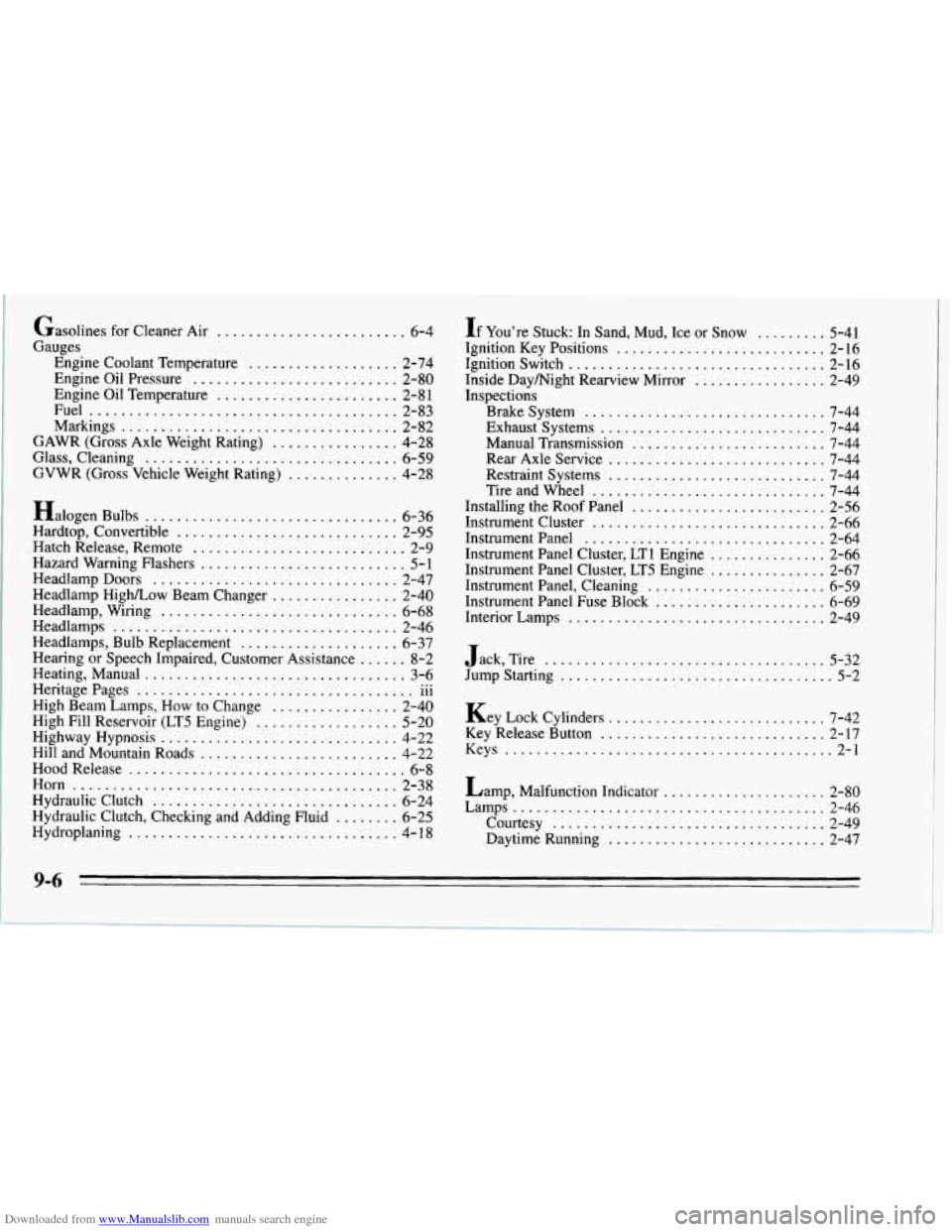
Downloaded from www.Manualslib.com manuals search engine Gasolines for Cleaner Air ........................ 6-4
Gauges Engine Coolant TemDerature
................... 2-74 " Engine Oil Pressure .......................... 2-80
Fuel ....................................... 2-83
Engine
Oil Temperature
....................... 2-81
Markings
................................... 2-82
GAWR (Gross Axle Weight Rating)
................ 4-28
GVWR (Gross Vehicle Weight Rating)
.............. 4-28
Glass,
Cleaning
................................ 6-59
Halogen Bulbs
................................ 6-36
Hardtop. Convertible
............................ 2-95
.Hatch Release. Remote
........................... 2-9
Hazard Warning Flashers
.......................... 5-1
Headlamp Doors ............................... 2-47
Headlamp HigWLow Beam Changer
................ 2-40
Headlamp. Wiring
.............................. 6-68
Headlamps, Bulb Replacement .................... 6-37
Heating, Manual
................................. 3-6
High Beam Lamps, How to Change
................ 2-40
High Fill Reservoir
(LT5 Engine) .................. 5-20
Highway Hypnosis
.............................. 4-22
Hill and Mountain Roads
......................... 4-22
HoodRelease
................................... 6-8
Horn
......................................... 2-38
Headlamps
.................................... 2-46
Hearing or Speech Impaired, Customer Assistance
...... 8-2
Heritage Pages
................................... 111 ...
Hydraulic Clutch ............................... 6-24
Hydraulic Clutch, Checking and Adding Fluid
........ 6-25
Hydroplaning
.................................. 4- 18
If You're Stuck: In Sand. Mud. Ice or Snow ......... 5-41
Ignition Key Positions
........................... 2-16
Ignition Switch
................................. 2-16
Inside Daymight Rearview Mirror
................. 2-49
Exhaust Systems
............................. 7-44
Manual Transmission
......................... 7-44
Rear Axle Service
............................ 7-44
Restraint Systems
............................ 7-44
Installing the Roof Panel
......................... 2-56
Instrument Cluster
.............................. 2-66
Instrument Panel Cluster,
LTl Engine ............... 2-66
Instrument Panel Cluster,
LT5 Engine ............... 2-67
Instrument Panel, Cleaning
....................... 6-59
Instrument Panel Fuse Block
...................... 6-69
Interior Lamps
................................. 2-49
Jump Starting
................................... 5-2
Key Release Button
............................. 2-17
Inspections
Brakesystem
............................... 7-44
Tireandwheel
.............................. 7-44
Instrumentpanel
............................... 2-64
J ack, Tire .................................... 5-32
Key Lock Cylinders
............................ 7-42
Lamp, Malfunction Indicator
..................... 2-80
Keys
.......................................... 2-1
Lamps
........................................ 2-46
Courtesy
................................... 2-49
Daytime Running
............................ 2-47
9-6